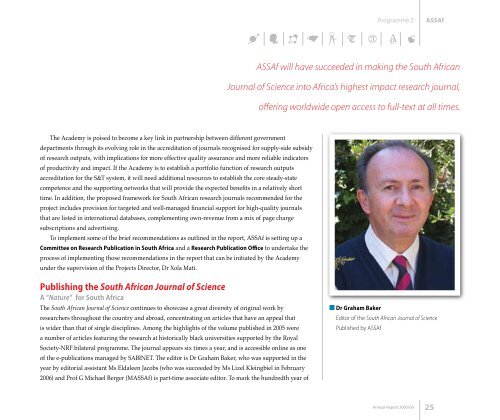Academy of Science South Africa 2005/6 Annual Report
Academy of Science South Africa 2005/6 Annual Report
Academy of Science South Africa 2005/6 Annual Report
- No tags were found...
You also want an ePaper? Increase the reach of your titles
YUMPU automatically turns print PDFs into web optimized ePapers that Google loves.
Programme 2ASSAfASSAf will have succeeded in making the <strong>South</strong> <strong>Africa</strong>nJournal <strong>of</strong> <strong>Science</strong> into <strong>Africa</strong>’s highest impact research journal,<strong>of</strong>fering worldwide open access to full-text at all times.The <strong>Academy</strong> is poised to become a key link in partnership between different governmentdepartments through its evolving role in the accreditation <strong>of</strong> journals recognised for supply-side subsidy<strong>of</strong> research outputs, with implications for more effective quality assurance and more reliable indicators<strong>of</strong> productivity and impact. If the <strong>Academy</strong> is to establish a portfolio function <strong>of</strong> research outputsaccreditation for the S&T system, it will need additional resources to establish the core steady-statecompetence and the supporting networks that will provide the expected benefits in a relatively shorttime. In addition, the proposed framework for <strong>South</strong> <strong>Africa</strong>n research journals recommended for theproject includes provision for targeted and well-managed financial support for high-quality journalsthat are listed in international databases, complementing own-revenue from a mix <strong>of</strong> page chargesubscriptions and advertising.To implement some <strong>of</strong> the brief recommendations as outlined in the report, ASSAf is setting up aCommittee on Research Publication in <strong>South</strong> <strong>Africa</strong> and a Research Publication Office to undertake theprocess <strong>of</strong> implementing those recommendations in the report that can be initiated by the <strong>Academy</strong>under the supervision <strong>of</strong> the Projects Director, Dr Xola Mati.Publishing the <strong>South</strong> <strong>Africa</strong>n Journal <strong>of</strong> <strong>Science</strong>A “Nature” for <strong>South</strong> <strong>Africa</strong>The <strong>South</strong> <strong>Africa</strong>n Journal <strong>of</strong> <strong>Science</strong> continues to showcase a great diversity <strong>of</strong> original work byresearchers throughout the country and abroad, concentrating on articles that have an appeal thatis wider than that <strong>of</strong> single disciplines. Among the highlights <strong>of</strong> the volume published in <strong>2005</strong> werea number <strong>of</strong> articles featuring the research at historically black universities supported by the RoyalSociety-NRF bilateral programme. The journal appears six times a year, and is accessible online as one<strong>of</strong> the e-publications managed by SABINET. The editor is Dr Graham Baker, who was supported in theyear by editorial assistant Ms Eldaleen Jacobs (who was succeeded by Ms Lizel Kleingbiel in February2006) and Pr<strong>of</strong> G Michael Berger (MASSAf) is part-time associate editor. To mark the hundredth year <strong>of</strong>Dr Graham BakerEditor <strong>of</strong> the <strong>South</strong> <strong>Africa</strong>n Journal <strong>of</strong> <strong>Science</strong>Published by ASSAf<strong>Annual</strong> <strong>Report</strong> <strong>2005</strong>/0625









![National Research Foundation Annual Report 2008 / 2009 [Part 2]](https://img.yumpu.com/49774036/1/177x260/national-research-foundation-annual-report-2008-2009-part-2.jpg?quality=85)






